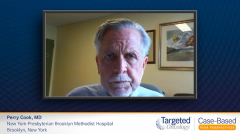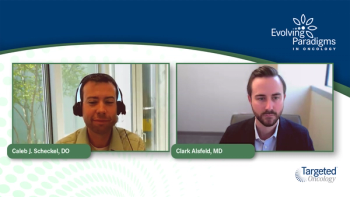
Case Presentation: A 76-Year-Old Man With Relapsed/Refractory Follicular Lymphoma
Perry Cook, MD, presents the case of a 76-year-old man with relapsed/refractory follicular lymphoma.
Episodes in this series

Perry Cook, MD: Hello, everyone. My name is Perry Cook. I’m a hematologist in the NYP [NewYork-Presbyterian] Brooklyn Methodist Hospital system, and the topic for today is follicular lymphoma. To make this more tangible, I thought we would start with a specific case of a patient with follicular lymphoma. The case I chose is a 76-year-old man who presented with nonspecific symptoms of about 4 to 6 months duration. He had increased fatigue, sudden GI [gastrointestinal] distress, and adenopathy. His past medical history is notable for hypertension, and he also has diabetes that is difficult to control; brittle diabetes. Ten years ago, he had a coronary artery bypass, but he’s been pain free from that point of view since the surgery. He lives by himself at a distance from any clinic; he’s 2 and a half hours away from my office. He lives upstate, in a rural area, and he comes down to the city for medical care. His physical examination is notable for multiple sites of adenopathy, and I can feel his spleen. His laboratory studies reveal a normal white blood cell count in differential, his granulocytes are just under 2000, his hemoglobin is just under 10 g/dL, his LDH [lactate dehydrogenase] is 150% of the normal range, and his platelet count is normal. His renal function is normal. His additional staging by CT reveals multiple sites of nonbulky adenopathy, bilateral axillary, cervical mediastinal, and retroperitoneal nodes. His staging continues with a bone marrow exam, which shows involvement. A lymph node biopsy reveals effacement of normal nodal architecture by lymphocytes, which are mature and present in a follicular pattern; 5% of them are large cells.
At this point, we can stage him by a FLIPI [Follicular Lymphoma International Prognostic Index] and by histology. His histology is REAL [Revised European-American Lymphoma] or WHO [World Health Organization] category 2. He has a moderate number of large lymphocytes. His FLIPI score is high because he’s over 60 years old. That’s 1 point. His LDH is elevated, that’s another point. His hemoglobin is decreased, so that’s a third point, and he has more than 3 sites of disease, so he has 4 points. He’s FLIPI high risk. He's symptomatic; he needs to be treated. He goes on to receive treatment with rituximab and bendamustine and achieves a complete remission. Following remission, he goes on to receive rituximab every 2 months. However, in the context of rituximab, he has evidence of progression of disease. What does that tell us about him? He had high-risk features at the start, and he’s one of the 25% of patients who progress within the first 2 years of starting therapy. This is a category of patients that has a guarded prognosis, and that we have to think carefully about what we give next. In his case, he has relapse, disease progression, he’s asymptomatic, and he’s observed for a period of time before he again declares himself symptomatic and needing additional therapy.
What is the time of relapse in this case? He relapsed 16 months from the time of initial therapy, while he was still receiving rituximab. This is a very worrisome finding for patients with follicular lymphoma. Those who relapse before the 24-month mark are very unlikely to achieve a meaningful response with additional chemoimmunotherapy. That’s why, in my opinion, retreating with bendamustine, with CVP [cyclophosphamide, vincristine, prednisone], or with CHOP [cyclophosphamide, doxorubicin, vincristine, prednisone], in combination with either obinutuzumab or rituximab, is unlikely to advance his case very much. [That is] why I would move on to an alternative therapy at this point.
How often do we see patients relapse before 24 months? The answer, unfortunately, is about a quarter of patients. That’s not enough that it affects the mean duration of first response, but it’s highly meaningful for these 25% of patients who progress early, because they’re very unlikely to achieve a significant benefit from additional chemoimmunotherapy. It’s important that we recognize this and move on to alternative therapies. If this patient were 50 years old instead of 76, or I guess at the time of progression 77 or 78, we could consider the possibility of an early CAR T [chimeric antigen receptor T-cell] intervention, or an early allogeneic transplant. But this patient, like most patients with follicular lymphoma, is older than the appropriate age for these more aggressive interventions.
This transcript has been edited for clarity.
Case: A 76-Year-Old Man With Relapsed/Refractory Follicular Lymphoma
Initial presentation
- A 76-year-old man complains of a 4-month history of bloating, fevers, and unintended weight loss of 9 lbs
- PMH: Medically-controlled hypertension, brittle diabetes, CABG 10 years prior
- SH: Lives by himself 2.5 hours from the clinic; only daughter lives out of state
- PE: palpable right axillary lymph nodes, ~ 3 cm and bilateral cervical lymph nodes, ~ 2 cm; spleen palpable 4.5 cm below left costal margin
Clinical workup
- Labs: ANC 1.6 x 109/L, WBC 11.4 x 109/L, 45% lymphocytes, Hb 9.5 g/dL, plt 96 x 109/L, LDH 426 U/L, B2M 3.4 µg/mL; HBV negative
- GFR 59 ml/min
- Excisional biopsy of the axillary lymph node on IHC showed CD 20+, CD 3+, CD5+, CD 10+, BCL2+; follicular lymphoma grade 2
- Bone marrow biopsy showed paratrabecular lymphoid aggregates, 42% involvement
- Cytogenetics: t(14;18) (q32;q21)
- Molecular testing: EZH2 wild type
- PET/CT showed right axillary, bilateral cervical, and mediastinal lymphadenopathy (3.3 cm, 3.4, cm and 2.6 cm, and 3.2 respectively)
- Ann Arbor Stage IV; ECOG 1
Treatment
- He was treated with bendamustine and rituximab for 6 cycles, achieved complete response and continued on rituximab maintenance
- Side effects included grade 3 diarrhea with BR
- 16 months later he complained of fevers and chills with increasing frequency
- Repeat PET/CT revealed progression of disease
- He received R-CHOP for 6 cycles and continued on rituximab maintenance
- 11 months later he had worsening fatigue and increased weight loss and work up revealed progressive disease
- He was started on tazemetostat 800 mg BID








































